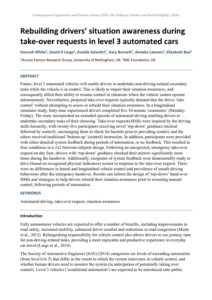| Document | Author Hannah White, David R Large, Davide Salanitri, Gary Burnett, Anneka Lawson, Elizabeth Box |
| Abstract Future, level 3 automated vehicles will enable drivers to undertake non-driving-related secondary tasks while the vehicle is in control. This is likely to impair their situation awareness, and consequently affect their ability to resume control in situations where the vehicle cannot operate autonomously. Nevertheless, proposed take-over requests typically demand that the driver ‘take control’ without attempting to assess or rebuild their situation awareness. In a longitudinal simulator study, forty-nine experienced drivers completed five 30-minute ‘commutes’ (Monday-Friday). The route incorporated an extended episode of automated driving enabling drivers to undertake secondary tasks of their choosing. Take-over requests/HMIs were inspired by the driving skills hierarchy, with twenty-five participants receiving novel ‘top-down’ guidance (tactical followed by control), encouraging them to check for hazards prior to providing control, and the others received traditional ‘bottom-up’ (control) instruction. In addition, participants were provided with either detailed system feedback during periods of automation, or no feedback. This resulted in four conditions in a 2x2 between-subjects design. Following an unexpected, emergency take-over request on day four, drivers with ‘top-down’ guidance checked their mirrors significantly more times during the handover. Additionally, recipients of system feedback were demonstrably ready to drive (based on recognised physical indicators) sooner in response to the take-over request. There were no differences in lateral and longitudinal vehicle control and prevalence of unsafe driving behaviours after the emergency handover. Results can inform the design of ‘top-down’ hand-over HMIs and strategies to help drivers rebuild their situation awareness prior to resuming manual control, following periods of automation. |

